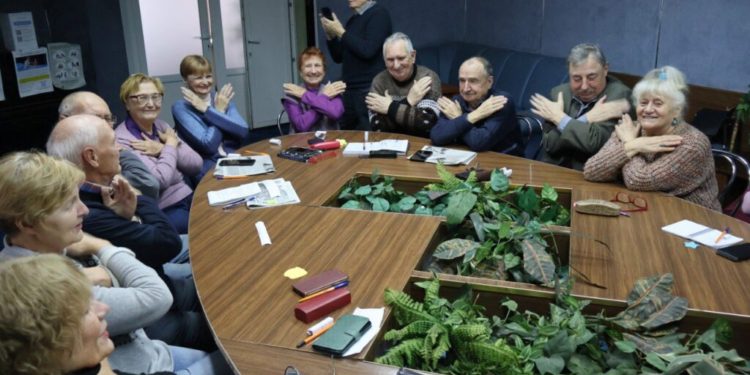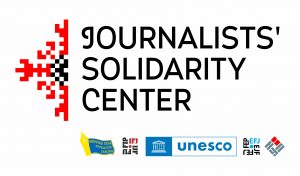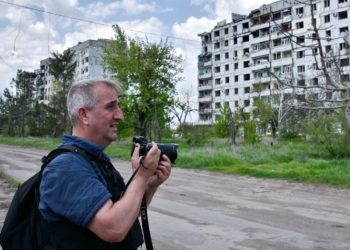How can journalists maintain their psychological state in order to be able to work and convey objective information to people about everything that is happening in the war and the front-line territories? This was discussed at the training called Preserving Stress Resistance During Wartime, which was conducted at the Zaporizhzhia Journalists’ Solidarity Center of the National Union of Journalists of Ukraine (NUJU) by experienced psychologists of the Posmishka.UA Charitable Foundation, Olha Manzhura, and Polina Pletnichenko. This was relevant for media workers in Zaporizhzhia because the city is currently living in a state of constant tension. The enemy has intensified attacks, and night explosions, shelling, and destruction have, unfortunately, become our terrible reality.
“More and more often, we feel psychological exhaustion. It is increasingly difficult to overcome negative emotions (fear, anger, sadness, despair, stupor, euphoria, exhaustion, and excitement) – this is a protective reaction of the body; our psyche activates them to cope with this emergency. But, when all these reactions are excessive to the point that a person can no longer cope, then self-regulation techniques and self-soothing formulas will come to the rescue, which is aimed at calming the overly activated nervous system,” noted Olha Manzhura.
During the training, media workers mastered these techniques. Also, they learned practical exercises and non-standard methods of mental self-regulation so that they have the strength to live, work, and not lose their fortitude.
Olha Manzhura and Polina Pletnichenko suggested that journalists create a stress resistance tree. The participants of the training glued leaves with the names of the self-soothing methods that they use. They added their advice on the leaves of the tree and the coach. Together, they discussed this collectively defined arsenal of techniques for maintaining and restoring stress resistance.
Then, from the psychologists’ “magic bag,” the media workers took out leaflets with new, non-standard recommendations and exercises that can be used to restore their own psychological stability, discussed and tested them with interest.
Under the guidance of the coaches, the training participants also performed a number of useful physical and breathing exercises and self-meditation techniques that can be a quick help with stress or psychological burnout. As a result of the theoretical and practical sessions, self-regulation techniques and self-soothing formulas became available to everyone, which the coaches willingly shared with journalists.
“There are a lot of these techniques, and they may seem primitive to you at first glance, but their benefit lies precisely in their simplicity. They work because they are based on the laws of neurobiology. We are not talking about the absolute relief of stress or anxiety. Under constant shelling and bombing, it is impossible to stay relaxed. But the mobilization of the body and mind makes it possible to work, save yourself, find the strength to resist, look for solutions, live, and believe in victory. That is, these are techniques that allow you to master excessive emotions and focus on what is important,” emphasized Polina Pletnichenko.
Journalists actively mastered new methods of restoring psychological stability and shared their impressions.
Self-soothing techniques. Tips for journalists.
Technique 1. Breathe
Take a deep breath through your nose and a deeper exhalation through the gap between your lips. 5-6 cycles of such breathing will slow down your heart rate and collect scattered thoughts. You may have noticed that during stressful events, people, and in particular, military personnel in war, often start smoking. So, for the most part, it’s not about tobacco but about breathing, which is specific to this process – one that calms the nervous system. You don’t need cigarettes for this; try to breathe the way you breathe when smoking, for about the same amount of time as it takes to smoke one cigarette – that is, 6-8-10 cycles of inhalation and exhalation.
Technique 2. Tap the body
During a panic attack or when emotions (of any kind) are spilling out over the edge, press your hands to your body, palms folded crosswise under your collarbones, and, like butterfly wings, tap your shoulders with your palms in a comfortable rhythm and with a comfortable force. You can also alternately tap your palms on your legs in the area just above the knees. This technique is called tapping. Two minutes of tapping activates the parasympathetic nervous system, which promotes recovery and ensures the body’s internal balance.
Technique 3. Move
Use any opportunity for physical activity. Even in confined spaces, you can alternately clench your hands into fists or raise and lower your feet, pressing them to the ground with effort.
Technique 4. Drink
A simple process like swallowing works very well to calm an overexcited nervous system. If you have water, take about 20 small sips in a calm rhythm (a sip – inhale and exhale or do it twice – a sip). Small children sometimes suck their thumb to calm down – the mechanism of action is the same.
Technique 5. Shake your body
If your whole body suddenly starts to shake uncontrollably – this is a normal reaction to shock. This way, the body gets rid of excess tension, literally “wakes up,” and brings you out of a state of numbness. Tremors are not harmful, so you should not try to stop them, but you can simply wait until the wave passes.
Or you can help yourself by increasing the tremor – for example, shaking your hips and shoulders and jumping slightly. If this happened to a child, you could offer to play – depict a dog that shakes off the water after bathing. And when the tremors subside, you can hug the child or gently take his hands in your palms.
Formulas for self-soothing:
- Reject this thought.
- Everything will be fine.
- The problem will be solved.
- It is not worth worrying about.
- I focus on my breathing.
- I feel healthy (healthy)
- I am absolutely calm (calm)
- How could I (could) worry about trifles?
- Thoughts are reasonable. I calmly consider my further actions.
At first glance, all this may seem banal. But try to practice, especially since it is not difficult at all! And you will feel how balance and emotional stability, confidence in your strengths and capabilities return to you. After all, mastering yourself means mastering the situation.
Call the Zaporizhzhia JSC at 096 277 5352 (Nataliya Kuzmenko and Valentyna Manzhura, the Zaporizhzhia JSC coordinators). The Center is located at 152 Sobornyi Avenue.
ABOUT JSC
The Journalists’ Solidarity Centers is an initiative of the NUJU implemented with the support of the International and European Federations of Journalists and UNESCO. The initiative is designated to help media representatives working in Ukraine during the war. The Centers operate in Kyiv, Lviv, Ivano-Frankivsk, Chernivtsi, Zaporizhzhia, and Dnipro and provide journalists with organizational, technical, legal, psychological, and other types of assistance.
ABOUT UNESCO
UNESCO is the United Nations Educational, Scientific, and Cultural Organization. It contributes to peace and security by promoting international cooperation in education, sciences, culture, communication, and information. UNESCO promotes knowledge sharing and the free flow of ideas to accelerate mutual understanding. It is the coordinator of the UN Action Plan on the Safety of Journalists and the Issue of Impunity, which aims to create a free and safe environment for journalists and media workers, thus strengthening peace, democracy, and sustainable development worldwide. UNESCO is working closely with its partner organizations in Ukraine to provide support to journalists on the ground.
The designations employed and the presentation of material throughout this digest do not imply the expression of any opinion whatsoever on the part of UNESCO concerning the legal status of any country, territory, city, or area or its authorities or concerning the delimitation of its frontiers or boundaries.
The authors are responsible for the choice and the presentation of the facts contained in this digest and for the opinions expressed therein, which are not necessarily those of UNESCO and do not commit to the organization.
Valentyna Bystrova
Photo by Dariya Zyrianova

 THE NATIONAL UNION OF
JOURNALISTS OF UKRAINE
THE NATIONAL UNION OF
JOURNALISTS OF UKRAINE
















Discussion about this post